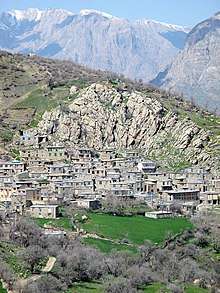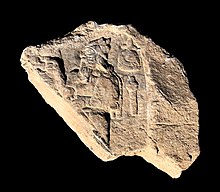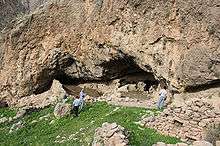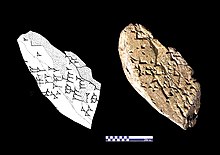Avroman
Avroman or Hawraman,[1] (Kurdish: Hawraman ,ههورامان,[2][3] Persian: اورامان[4]) is a mountainous region located within the provinces of Kurdistan and Kermanshah in western Iran and in north-eastern Kurdistan Region of Iraq.

Avroman has many springs and rivers that most their water mainly flows into Sirwan River. Bil spring (or Kani Bil) is one of these springs which has a discharge about 3000-4000 liters per second. The river which is made of Bil spring is the shortest river in the world with a total length of 15 meters.[5][6] Construction of Darian Dam on the Sirwan River between 2009 and 2015 initiated The Darian Dam Archaeological Salvage Program that led to discovery of many archaeological sites before flooding of the reservoir.
Archaeology and History

The earliest archaeological evidence shows that the region was inhabited by human since Middle Paleolithic Period. This evidence were discovered by archaeologists near Hajij village and include stone tools that made by Neanderthals or Early Modern Humans.[7] Evidence for Late Paleolithic occupation discovered in a cave site in the Perdi Mala valley.[8]

The Inscription of Sargon II at Tang-i Var pass near the village of Tang-i Var, indicate that the region was occupied by Assyrians during their military campaigns into Zagros.
The Parchments of Awraman, a set of three documents from the Seleucid and Parthian eras, were found in the region in 1909. They were discovered in a cave on Kuh-e Salan Mountain, near the village of Shar Hawraman, and subsequently sent to London.
Ancient religions are also practiced throughout Avroman and the region is home to the ancient holy places of the Yarsan faith. Some scholars believe that the name Hawraman or Huraman has strong connections to the ancient Zoroastrian faith and claim that the name may have originated from Ahuraman or Ahura Mazda.[9] Ahura Mazda is the name of God in the ancient Indo-Iranian Avestan language and comes from the ancient Zoroastrian faith, which is still being practiced by very small numbers of people in the region. Many areas in the Avroman region are believed to have been pilgrimage sites for Zoroastrians prior to the advent of Islam.[10] One of the oldest Islamic period evidence is Negel quran. A leather-bound Quran written in the Kufic script with gilded page borders, dates to 4th century AH (913 CE – 1009 CE) which kept in the village mosque.


Culture
The inhabitants of Avroman are Kurdish people,[11][12][13][14] who speak the Hawrami dialect of the Gorani language.[15] Traditional clothing for women includes either a vest or long-sleeved jacket or long overcoat worn over a gown. An under dress and puffy pants is worn beneath the gown. Traditionally women wore Kurdish hats ornamented with valued coloured stones, beads and gold pieces. Usually younger women and young girls wear brightly coloured dresses adorned with many beads and sequins and the older women wear darker colours and white head-cover. Hawrami men generally wear a shirt; a vest with an open neck; and baggy trousers fitted at the ankles. A cotton sash 3–4 m long is folded in half lengthwise and wrapped tightly around the torso on waist. Men also wore traditional brown felt jackets with pointed shoulders called Kolabal.
Siyaw Chemane is a style of singing practiced by the Kurds in Avroman people and means dark eyes in Hewrami. It is performed without the use of any instruments, with the exception of the occasional use of a Kurdish hand-drum or Daff. Today, the Siya Cheman style is used mostly for storytelling and entertainment.
References
- D. N. MacKenzie, Avroman, Encyclopedia Iranica
- "ڕاپۆرتی کوردستانی". Peyserpress (in Kurdish). 12 July 2020. Retrieved 20 July 2020.
- Kemaloğlu, Nasır (2 March 2016). "Zaravayên Kurdî". zazaki.net (in Kurdish). Retrieved 15 August 2020.
- حسين علي, رزمآرا (2008). عملىات اورامان (in Persian). پردىس دانش.
- "Kani Bil:Iranian TV; Kurdistan province". Archived from the original on 2014-08-26.
- "Rudaw:Kani Bil is in crisis". Archived from the original on 2014-08-26. Retrieved 2014-08-30.
- "Digs hint 40,000 yrs. of man life in Hawraman".
- Biglari, F and S. Shidrang (2019) Rescuing the Paleolithic Heritage of Hawraman, Kurdistan, Iranian Zagros, Near Eastern Archaeology 82 (4): 226-235.https://doi.org/10.1086/706536
- Nyberg, H.S. (1923), The Pahlavi documents of Avroman, Le Monde Oriental, XVII, p.189. This is very interesting for those interested in investigating the survival of Parthian usage of Zoroastrian terminology among the local Kurds of modern day Hawraman (Avroman).
- CHN | Tourism and Travel Archived 2008-10-10 at the Wayback Machine
- Edmonds, Cecil. Kurds, Turks, and Arabs: politics, travel, and research in northeastern Iraq, 1919-1925. Oxford University Press, 1957.
- home.hum.uva.nl/oz/leezenberg/GInflCK.pd
- "KURDISH TRIBES – Encyclopaedia Iranica". www.iranicaonline.org.
- The Kurdish National Movement: Its Origins and Development by Wadie Jwaideh page 307
- "KurdishAcademy". kurdishacademy.org.
External links
- Omid Sālehi, Customs of the Land of Stone and Wind (Ā'in-e Sar'zamin-e Sang va Bād), in Persian, Jadid Online, 5 May 2009, .
Audio slideshow: (5 min 39 sec).
Note: The place shown in the above audio slideshow is Orāmān, to the North of Pāveh. As of today (May 2009), this place has a population of approximately 3500.
